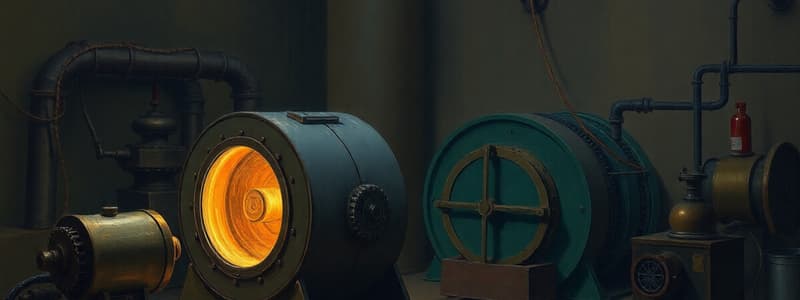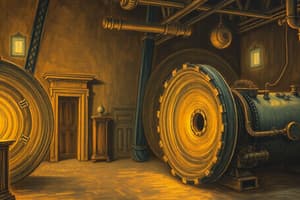Podcast
Questions and Answers
What is the primary function of a DC generator?
What is the primary function of a DC generator?
- To convert electrical energy into mechanical energy
- To store electrical energy in batteries
- To generate alternating current for household use
- To convert mechanical energy into direct current electricity (correct)
Which principle explains the operation of a DC generator?
Which principle explains the operation of a DC generator?
- Kirchhoff's Voltage Law
- Newton's Laws of Motion
- Ohm's Law
- Faraday's Law of Electromagnetic Induction (correct)
What component in a DC generator ensures the current flows in a single direction?
What component in a DC generator ensures the current flows in a single direction?
- Field windings
- Commutator (correct)
- Armature
- Brushes
Which of the following is not a typical application of DC generators?
Which of the following is not a typical application of DC generators?
What does the term 'unidirectional flow of current' mean in the context of DC generators?
What does the term 'unidirectional flow of current' mean in the context of DC generators?
What is the role of the armature in a DC generator?
What is the role of the armature in a DC generator?
In which industrial application would you most likely find a DC generator?
In which industrial application would you most likely find a DC generator?
What happens when a conductor moves through a magnetic field in the context of a DC generator?
What happens when a conductor moves through a magnetic field in the context of a DC generator?
What is the primary characteristic of a shunt-wound DC generator?
What is the primary characteristic of a shunt-wound DC generator?
Which application is NOT typically associated with self-excited DC generators?
Which application is NOT typically associated with self-excited DC generators?
What distinguishes a compound-wound DC generator from other types?
What distinguishes a compound-wound DC generator from other types?
Why are self-excited DC generators capable of starting with residual magnetism?
Why are self-excited DC generators capable of starting with residual magnetism?
In what situation would a series-wound DC generator be most appropriately used?
In what situation would a series-wound DC generator be most appropriately used?
Which winding type is best suited for low-voltage, high-current applications?
Which winding type is best suited for low-voltage, high-current applications?
What is the main advantage of separately-excited DC generators?
What is the main advantage of separately-excited DC generators?
In wave winding, how many parallel paths are formed regardless of the number of poles?
In wave winding, how many parallel paths are formed regardless of the number of poles?
Which application is suitable for wave winding due to its design?
Which application is suitable for wave winding due to its design?
What are the key features of a separately-excited DC generator?
What are the key features of a separately-excited DC generator?
Which winding type combines both lap and wave winding characteristics?
Which winding type combines both lap and wave winding characteristics?
Which winding type is NOT suitable for high-voltage, low-current applications?
Which winding type is NOT suitable for high-voltage, low-current applications?
What is a disadvantage of separately-excited DC generators?
What is a disadvantage of separately-excited DC generators?
What is the purpose of the field windings in a DC generator?
What is the purpose of the field windings in a DC generator?
How does the commutator function in a DC generator?
How does the commutator function in a DC generator?
What does the yoke of a DC generator provide?
What does the yoke of a DC generator provide?
What happens to the direction of the induced EMF as the armature rotates in a DC generator?
What happens to the direction of the induced EMF as the armature rotates in a DC generator?
What differentiates lap winding from other types of armature windings?
What differentiates lap winding from other types of armature windings?
What role do brushes play in a DC generator?
What role do brushes play in a DC generator?
In a DC generator, what is the significance of the pole core?
In a DC generator, what is the significance of the pole core?
Why is the segmented construction of the commutator important?
Why is the segmented construction of the commutator important?
Flashcards are hidden until you start studying
Study Notes
Overview of Electric Generators
- Electric generators convert mechanical energy into electrical energy using electromagnetic induction, discovered by Michael Faraday in 1831.
- When a conductor moves through a magnetic field, it induces an electromotive force (EMF) that drives electric current in a closed circuit.
- Generators are classified into AC (alternating current) and DC (direct current) generators based on the type of current produced.
DC Generators and Applications
- A DC generator converts mechanical energy into direct current electricity, providing a unidirectional flow.
- Primary components: armature, field windings, commutator, and brushes.
Applications of DC Generators
- Battery Charging: Commonly used in automotive applications.
- Power Supply for DC Motors: Provides power in industrial settings.
- Welding: Essential for arc welding, requiring steady current.
- Electroplating: Critical for processes needing steady current.
Principle of Operation
- Based on Faraday’s Law, an EMF is induced when the armature rotates within a magnetic field, allowing the flow of direct current through a commutator.
- The commutator converts alternating EMF into unidirectional EMF by reversing coil connections to the circuit.
Construction and Components of DC Generators
- Armature: Rotating part where EMF is induced; includes a coil of wire on an iron core.
- Field Windings: Coils that create the magnetic field, energized by a DC source.
- Commutator: Mechanical rectifier converting alternating EMF into direct current.
- Brushes: Carbon or graphite blocks ensuring electrical contact between the commutator and external circuit.
- Yoke: Outer frame providing support and forming part of the magnetic circuit.
- Pole Core and Pole Shoe: Parts of the magnetic circuit; pole core supports field winding; pole shoe distributes magnetic flux uniformly.
Working Principle of a DC Generator
- As the armature rotates, conductors cut through the magnetic field, inducing EMF in the armature conductors.
- The commutator ensures that current flows in a single direction, even as EMF direction changes.
Types of Armature Windings
- Lap Winding:
- Configuration connects each coil end to the next, forming multiple parallel paths; suited for low-voltage, high-current applications.
- Wave Winding:
- Series wave-like connection creates only two parallel paths; ideal for high-voltage, low-current applications.
- Frog-leg (or Combined) Winding:
- Balances characteristics of both lap and wave windings for flexible current and voltage requirements.
Generator Configuration Problem
- Consideration of a 4-pole DC generator with specific parameters, including armature slots, coil sides, commutator segments, RPM, and total flux per pole.
Types of DC Generators
-
Separately-Excited DC Generators:
- Field winding powered by an independent DC source.
- Offers independent control of magnetic field, resulting in stable voltage output.
- Applications include laboratory experiments, testing, and processes like electroplating.
-
Self-Excited DC Generators:
- Field winding is connected to the generator's output, relying on the generator to excite itself.
- Types:
- Shunt-Wound: Parallel connection, good voltage regulation, used for constant voltage applications.
- Series-Wound: Series connection, output voltage varies with load; suitable for variable voltage requirements.
- Compound-Wound: Combines both series and shunt windings, providing better voltage regulation and load capacity.
Studying That Suits You
Use AI to generate personalized quizzes and flashcards to suit your learning preferences.




